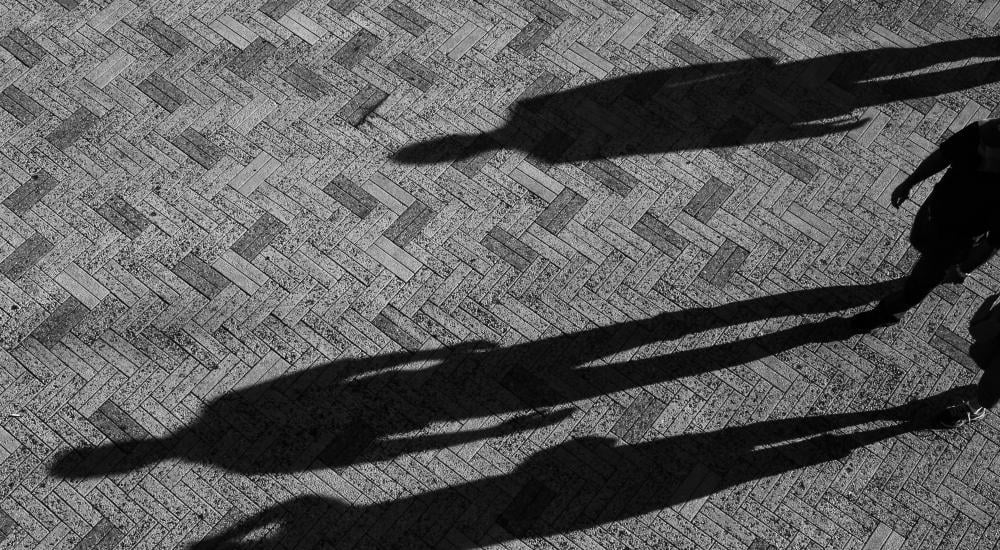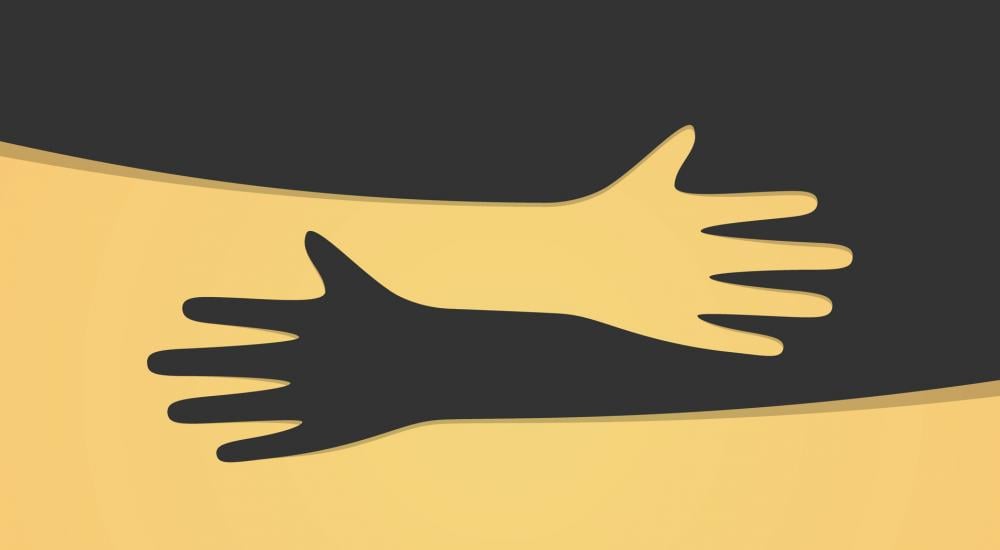Conflict and Change
Editor's note: Responding to global conflict has been part of international education from the outset. While this issue of IE was in production long before war broke out in the Middle East, this article has taken on added significance in light of current events. The institutions and groups featured here illustrate different approaches to the way forward after conflict, as well as the role of international education in peacemaking.
Not many universities have an acting wartime vice president of international affairs, but these are not ordinary times at the Kyiv School of Economics (KSE), a small institution in the Ukrainian capital that has found itself in the global spotlight since the Russian invasion began in February 2022.
“We had a difficult task—we wanted to get help,” says Tymofi Brik, who was an assistant professor of sociology at the KSE before being tapped for his wartime position. “At the same time, we had a strategic goal to signal that we are reliable partners and that Ukraine still operates. People approached Ukraine similarly to Afghanistan or Syria, with the perception that everything was destroyed. We had to educate them.”
Brik, who was named the university’s rector and vice president of international relations last year, has signed nearly 50 memorandums of understanding with universities in the United States and around the globe since the war began—at times while conducting Zoom calls from bomb shelters.
These partnerships look different from traditional connections between U.S. institutions and those in conflict-impacted regions. Echoing Ukrainian President Volodymyr Zelenskyy’s oft-repeated comment on the eve of the invasion—“I need ammunition, not a ride”—many of these new partnerships focus on supporting students and scholars in Kyiv.
"People approached Ukraine similarly to Afghanistan or Syria, with the perception that everything was destroyed. We had to educate them.”— Tymofi Brik
For example, universities such as the University of Massachusetts-Amherst have created nonresident virtual scholar-in-residence programs with KSE. Faculty at Northwestern University have collaborated virtually with Brik on research on the impact of propaganda in a warzone. And the University of Houston, which has offered a dual-credit economics program with the KSE for more than a decade, moved forward this year with plans to expand the program to a dual bachelor’s degree despite the war, with the goal of “creating a strong pipeline of international students with hands-on experience developing an economy during and after wartime,” according to the University of Houston’s press release.
“It is crucial for us to stay in Ukraine, to invest in resilience with human and social capital,” Brik says. “We have to invest in people, because people invest in institutions, and institutions save lives.”
These new approaches to working with institutions in war-torn regions have helped the KSE continue research, support students at institutions across the country, and raise millions of dollars for humanitarian causes and medical support in Ukraine. Brik hopes that the KSE serves as an example for others with international partnerships in areas affected by conflict.
“We think Ukraine can provide a useful model to help build local capacity, work with people at the local level, and build sustainable institutions,” Brik says. “It’s not easy to convince [institutions to change]… because it’s difficult to change paradigms.”
‘A Dangerous Turn’
Even so, global patterns are shifting. “The world took a dangerous turn in 2022,” the Council on Foreign Relations’ annual Preventive Priorities Survey, which assesses potential global conflicts, declared at the start of this year—and that was before rivalries between the United States, China, and Russia intensified and the October 7 attacks in Israel set the region on a wartime footing.
The council’s Global Conflict Tracker currently counts 27 nations experiencing conflict, including declared wars in Ukraine and Yemen, as well as civil wars, criminal violence, violent extremism, territorial disputes, instability, and long-standing tensions and confrontations between nation-states in every region of the world.
At the same time, scholars, students, and institutions around the world are facing growing threats to academic freedom—and their safety. According to the 2023 Academic Freedom Index, half the world’s population—more than 4 billion people—are living in countries where universities and scholars have significantly less freedom than a decade ago. The Scholars at Risk Freedom to Think report documented a record 391 attacks on higher education communities in 65 countries and territories in 2022, with student expression the most common target.
“Additional evidence of deteriorating conditions for academic freedom can be found in the increasing numbers of scholars and students seeking help,” the report stated.
‘A Global Peace System’
It is through this lens that higher education institutions in the United States and around the world are defining their role in resolving conflict, maintaining international scholarship, and helping conflict-impacted regions rebuild after the cessation of hostilities.
Through the support of endangered students and scholars, internationalization on campus, partnerships with institutions around the world, and student and scholar exchange, international educators “are part of a global peace system,” says Barbara Wien, senior professorial lecturer in American University’s Department of Peace, Human Rights, and Cultural Relations. “Whether they recognize it or not, they are part of networks of millions of civic organizations, institutions, and systems trying to put the brakes on violent conflict through cross-cultural understanding, diversity, and pluralism.”
Those are all long-standing objectives for international education. The rapid growth of international student and scholar mobility following World War II was explicitly tied to rebuilding Europe and navigating the tensions that would manifest during the Cold War and beyond it.
And U.S. institutions have long served as refuges for those fleeing conflict. Continuing in this tradition, Arizona State University (ASU) was honored with NAFSA’s 2023 Senator Paul Simon Spotlight Award for its Afghan Women’s Education Project. In late 2021, this initiative welcomed to ASU more than 60 former students from the Asian University for Women in Bangladesh. The women first had to leave their university when it closed during the COVID-19 pandemic and then fled Afghanistan amid the chaos after the U.S. military withdrew from the country.
“It’s part of our responsibility as U.S. institutions of higher education to consider our role as global partners when it comes to conflict and postconflict."—Sarah Schmidt
Pamela DeLargy, executive director of the Education for Humanity program, worked to bring the former Afghan students to ASU from Wisconsin, where they were being processed for resettlement. In May 2023, Maryam Alizada became the first of the Afghan women to graduate. Not surprisingly, Afghanistan saw the largest decline in academic freedom in the 2023 Academic Freedom Index. ASU also has welcomed former higher education leaders from the region, including Rangina Hamidi, Afghanistan’s former acting minister of education, and Faheem Hussain, a founding faculty member of the Asian University for Women.
In addition to continuing the work of resettling refugees, international educators are also navigating new considerations in conflict-affected regions, including efforts to decolonize peacemaking strategies and forge more equitable relationships between the Global North and the Global South.
“It’s part of our responsibility as U.S. institutions of higher education to consider our role as global partners when it comes to conflict and postconflict,” says Sarah Schmidt, instructor in Kent State University’s School of Peace and Conflict Studies and assistant director of global education initiatives at Kent State University-Stark. “To my mind, the most important factor is to be deeply attuned to the different power dynamics that are always going to be in play.”
International educators also must recognize the impact of global conflict on U.S. institutions, as demonstrations involving the Israel-Hamas conflict in Gaza have roiled campuses and drawn the attention of lawmakers this fall.
“We should never shy away from controversy,” says Wien. “Students are very aware of trends in the world, and if we don’t have honest and courageous conversations, they’re going to feel betrayed.”
Learning from Peace
U.S. institutions looking beyond their borders not only to be aware of conflicts but for examples in resolving conflicts as well. Pacifique Niyonzima left Rwanda in 2011 as a teenager, the youngest member of his Tutsi family to survive the nation’s genocide. Today, he is director of Kent State University’s center in Kigali, leading its partnership with the University of Rwanda.
The partnership has its roots in Niyonzima’s keystone project as a master’s degree student in higher education administration. It has grown to include a summer institute for Kent State’s School of Peace and Conflict Studies—during which visiting students learn about the nation’s reconciliation process following the its 1994 genocide—as well as research partnerships and a global peace education conference, which drew participants from 14 countries around the world this summer.
Kent State is also hosting four Rwandan national police officers, two of whom are in its peace and conflict studies program, and Kent State and the University of Rwanda hope to develop a 2+2 program where African students can begin their studies at the University of Rwanda and complete their degree at Kent State.
“It’s one of our deepest and most robust partnerships,” says Schmidt. “Students walk away with a much deeper understanding of not just postgenocide reconstruction but peace resolution more generally.”
Peace studies are critical in a world where countries emerging from war have a 50 percent change of relapsing into violence, according to Wien, citing statistics from the World Peace Commission. Today, there are more than 500 university-level peace study programs in the United States and Canada, in addition to many others around the world.
“Universities are the data centers of what works,” Wien says. “As incubators and research engines, they are indispensable for objective research of what’s going on.”
They also focus on the role of education within conflict-affected regions, something thatwas often overlooked by the first generation of peace-building institutions and nongovernmental organizations, according to Wien. For example, Wien has worked with the University of Maryland School of Education to conduct a textbook analysis for 14 countries in the Middle East to determine how the materials used in schools portray nations’ enemies. Doing so is essential to “separate government policies from the people,” she says. “The Russian people aren’t [Russian President Vladimir] Putin. The Palestinian people aren’t Hamas. And on and on.”
“Universities are the data centers of what works."—Barbara Wien
Rwanda, which introduced a nationwide K–-12 peace education curriculum in 2016, illustrates how the narrative around peace studies is changing. Its leaders have followed an approach to reconciliation that distinctly reflects the nation’s culture and the impact of colonialism over more than a century, according to Schmidt.
“When you look at Rwanda compared to other places that have faced mass atrocities and conflict where a sense of paternalism comes out in peace-building processes, that was not at all the case,” she says. “Everything was very localized. The unity government’s idea when developing peace-building mechanisms was to go back to pre-colonial Rwandan culture and build from there.”
That has broad implications for peace education in the United States, according to Schmidt. “There’s an old school idea that there’s a global idea of what peace looks like,” she says. “There’s now a push in the field to contextualize, localize, and challenge that universal component. If anything, the University of Rwanda is teaching us how we think about conflict and peace.”
Seeking a ‘Utopia’ Within Local Contexts
Institutions in other regions of the world are also developing sustainable models for addressing conflict in their contexts.
In Colombia, the Universidad de La Salle is focusing on addressing decades of consistent but changing causes of rural violence that have driven people from rural areas to seek refuge in cities, driving inequality and poverty, according to Libardo Gutiérrez Mengual, the university’s rector and director of international and interinstitutional relations.
The college’s Utopia project, launched in 2010 in Colombia’s Yopal-Casanare Department, provides something rarely found in the country’s rural areas—access to higher education and a safe campus environment for students from conflict-affected backgrounds. The first rural university in the country, Utopia focuses on entrepreneurial projects that allow students to return to their hometowns, modernize agriculture, and create jobs to reduce migration to urban areas.
Utopia’s nearly 400 alumni have been involved in a variety of projects in rural regions, including launching a direct coffee export business, building community irrigation projects, and becoming involved in public service.
“These opportunities,” Gutiérrez Mengual says, “are a key part of peace-building in Colombia.”
They’re also an opportunity for internationalization. Utopia now has six French and two Mexican students, and Universidad de La Salle is seeking international partners to “scale up the project,” Gutiérrez Mengual says. In particular, Utopia wants to send all students back to their home communities with drones to support precision agriculture, which requires training, maintenance, and other support. And while that kind of technical support is typical of Global North-South relationships, Gutiérrez Mengual also points to “South-South cooperation,” arguing that the Utopia project holds lessons for other countries that have seen long periods of conflict.
“These opportunities a key part of peace-building in Colombia."—Gutiérrez Mengual
“It’s a unique experience, and we would like to share that,” he says. “We consider Utopia a peace laboratory. Even though our students come from very different backgrounds, they are looking to the future—for themselves, their families, and the whole country.”
What’s Next
For international educators, it’s important that they recognize their role in this pivotal moment. “We have very current events showing how complicated this can get,” Schmidt says. “We need spaces where we can raise awareness and develop partnerships as scholars. It couldn’t be more relevant.”
Noting that study abroad programs are “a huge bulwark against hate” in their own right, Wien urges international offices to collaborate with peace studies programs to elevate programming so students “bring back greater international understanding and peaceful attitudes,” she says. “I don’t think we’ve capitalized on this enough.”
“We need spaces where we can raise awareness and develop partnerships as scholars. It couldn’t be more relevant.”—Sarah Schmidt
In Kyiv, the KSE is already looking beyond the war. The institution, which now admits three times as many students as it did before the invasion, has created new programs in urban studies, memory studies, psychology, and law to support Ukraine’s postconflict recovery and help address questions about reconciliation with Russia, preserving democratic institutions, and reintegrating military veterans into society, according to Brik.
“The challenge is how to keep up with this synergy,” he says. “We want to be a good example in the world.” •
About International Educator
International Educator is NAFSA’s flagship publication and has been published continually since 1990. As a record of the association and the field of international education, IE includes articles on a variety of topics, trends, and issues facing NAFSA members and their work.
From in-depth features to interviews with thought leaders and columns tailored to NAFSA’s knowledge communities, IE provides must-read context and analysis to those working around the globe to advance international education and exchange.
About NAFSA
NAFSA: Association of International Educators is the world's largest nonprofit association dedicated to international education and exchange. NAFSA serves the needs of more than 10,000 members and international educators worldwide at more than 3,500 institutions, in over 150 countries.
NAFSA membership provides you with unmatched access to best-in-class programs, critical updates, and resources to professionalize your practice. Members gain unrivaled opportunities to partner with experienced international education leaders.














